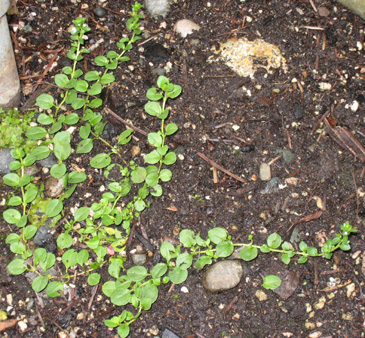
|
| Thymeleaf Speedwell; Veronica serpyllifolia L. |
Plantain Family; PLANTAGINACEÆ
|
formerly Figwort Family; SCROPHULARIACEÆ
|
| During April and May several species of
Veronica can enliven lawns as weeds, conspicuous by their small blue flowers.
Lawn Veronica (V. filiformis) was written about in May 1987. Germander Speedwell
(V. Chamædrys) is larger, more lovely, and less
weedy. Thymeleaf Speedwell is the smallest, least attractive, and least conspicuous. A fourth species,
V. officinalis, is rare: on drier lawns occasionally. When you see little blue flowers sprinkled across a lawn, you're seeing one or another of these weeds. Some park
lawns have three different species growing together. |
| Thymeleaf Speedwell is native over much of temperate North America, including our area, and we also now have a
weedy subspecies from Europe. The scientific name
serpyllifolia was derived from the Latin
Serpyllum, meaning Thyme. Unlike thyme,
this little plant prefers moist, heavy soil, partial sunlight, and doesn't endure competition well. Buttercups often favor the same
conditions (but trample the competition). |
| If Thymeleaf Speedwell's flowers were not so pale and tiny, it might serve as an ornamental groundcover for
poorly-drained sites --much as a species sold in nurseries, Veronica repens. The plant grows as a winter annual or is a short-lived perennial. I kept it going for years in the Tilth weed patch by snipping
its spent flower-stalks. |
| Other names are Spreading Speedwell. It has a rubbery texture, small size, and low habit of growth, only a few inches tall. It
is definitely not worth eating, being bland at best but usually slightly bitter, not to mention tiny and dirt-encrusted. |
The related Water Speedwell or American Brooklime
(V. americana), a spicy edible that often grows with watercress, is
worth eating. Rhoda Whittlsey reports "Speedwell is an old English benediction for departing guests." So,
speedwell!
|
Originally published as the Seattle Tilth newsletter Weed of the Month in May 1993, along with an illustration from a book.
Back |
|
|

